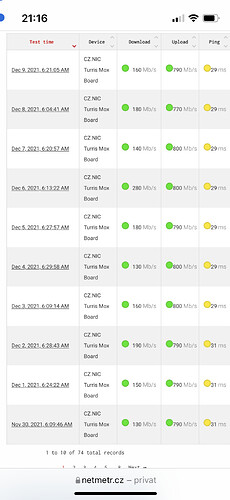I use NetMetr on my Omnia to cyclically monitor the performance of my DSL access. I often see very low download performance there at certain times, which does not correspond to reality. Speed tests on other services show full bandwidth. Is the NetMetr service unreliable at this point? The values sometimes show 1MBit/s, while the manual test, e.g. at wieistmeineip.de, shows the full bandwidth of 100MBit/s. Are there any similar experiences or explanations here?
Mmmh, I run netmetr every 2 hours and I pretty much get the speeds I can expect (close to my traffic shaper setting when the network is idle, otherwise its fair share of the capacity). I use a VDSL2-line in Germany (100/40, O2/Telefonica, L3-BSA). Do the low rates always happen at similar times, if yes when?
The low rates happen not every day. But mostly in the evening between 6 and 9pm.
What happens if you run a manual netmetr test at the same times? You might need to run a few of those to see whether you always get the expected rates (aslso make sure you get a feel for the other traffic during the time of the test, so you can scale your expectancy, if you run a test during heavy downloading you will not see anything close to 100 Mbps, but 1.4 seems too low even for that competition). If you can recreate the issue with netmetr’s webtest, the next step would be to see whether you can recreate it with say your ISP’s recommended speedtest in the same periods (but you did that already). It is theoretically possible that during peak time the connection between your ISPs network and the network netmetr servers are hosted in is simply overloaded. Which ISP are you using?
Netmetr servers are supposedly located in Czechia.
If I understood correctly, you are located in Germany.
http://wieistmeineip.de/ is supposedly in Germany as well.
Netmetr results might indicate that during those times, there are some bottlenecks in links between CZ and DE data centers.
You might see something similar if you select some more exotic server locations in speedtest.net.
For me always gives very similar results, so I guess is reliable at least in CR.
I”m located in sweden and my experience is also low speeds, and high latency. Especially download speeds.
Other services around europe or farther away show higher speed and lower latency.
E.g.
speedtest.net
On a speetest node located on my isp backbone I get consistent 900Mbps measures up and down.
And yes I have run the web test as well as the ”build in” tos version, picture below is from mox plugin figures.
And I have tried change the time it runs every hour from 02-06 with no real change
It is a bit tricky to know where the bottle neck is though.
Yes, it is, but as a first step you could:
use tcpdump on the router to figure out which address netmetr servers sit behind and then use:
mtr -ezb ${netmetr.server.IP.address}
to see how latency and packet drops develop along the path, first under idle coditions, then with netmetr tests running. A congested peering point will show up as a step-function on either packet-loss, RTT or both, please note that increases in loss or RTT that are restricted to intermediate hops only and do not also affect the remote end-point are not really diagnostic for congestion. (Intermediate hops often use ICMP rate limiting and/or de-prioritisation so need some care in interpretation). Now ideally you also need an mtr in the reverse direction, so from the netmetr servers or from a host in the same data-center and/or same AS, but that might be hard to come by.
You can chose different speedtest nodes around the world, and I have.
dslreport and waveform and fast(dot)com is other test that shows higher speeds for me.
Shure tools like tcpdump, mtr, dig and whois will also help undrerstand how the traffic is routed and perhaps help with finding bottlenecks, if that is important.
When I have the time I will make a more structured test and report.
But for now I’m just accepting the fact and do not paying a lot of attention to it.
Just wanted to share my own experience, as it is some what similar to OP
Thank You all for your excellent feedback. Yes, I am located in Germany and my testing leads me to believe that these are effects of the connection to the server in CZ. Local tests to servers in Germany do not show this effect.
Since the effects are mostly in the evening hours, I suspect that it is due to the route D → CZ. The local Telekom DSL connection seems to be stable in terms of performance.
Mmmh, if Telekom is your ISP, I bet that the netmetr servers are reached not via direct peering but via one of the big T1-ISPs or big transit providers like cogent… correct?
Yes, that’s the case.
This topic was automatically closed after 60 days. New replies are no longer allowed.

